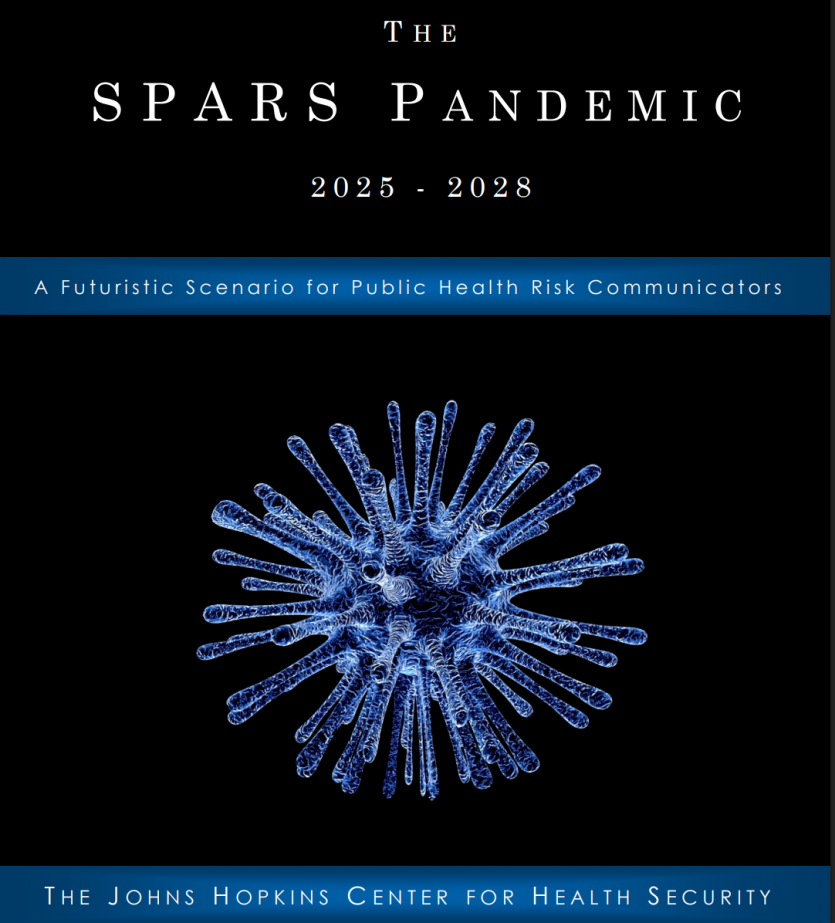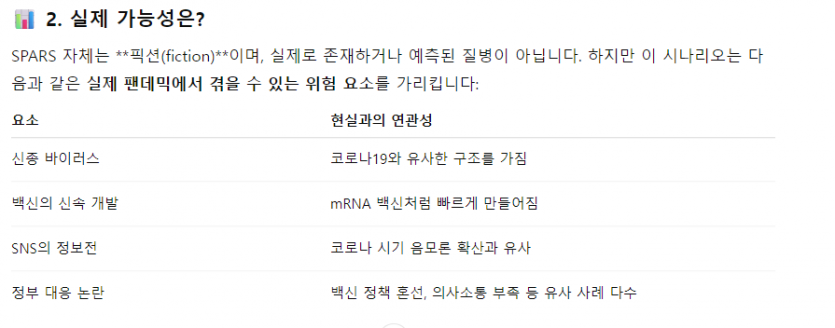SPARS Pandemic을 알아봅니다.미국 존스홉킨스 보건안전센터(Johns Hopkins Center for Health Security)**에서 2017년에 발표한 가상의 팬데믹 시나리오
작성자 정보
- 삼둡 작성
- 작성일
컨텐츠 정보
- 4,244 조회
- 목록
본문

Scenario Purpose The following narrative comprises a futuristic scenario that illustrates communication dilemmas concerning medical countermeasures (MCMs) that could plausibly emerge in the not-so-distant future. Its purpose is to prompt users, both individually and in discussion with others, to imagine the dynamic and oftentimes conflicted circumstances in which communication around emergency MCM development, distribution, and uptake takes place. While engaged with a rigorous simulated health emergency, scenario readers have the opportunity to mentally “rehearse” responses while also weighing the implications of their actions. At the same time, readers have a chance to consider what potential measures implemented in today’s environment might avert comparable communication dilemmas or classes of dilemmas in the future.
시나리오 목적
다음 이야기는 멀지 않은 미래에 나타날 수 있는 의료 대응책(MCM)과 관련된 커뮤니케이션 딜레마를 보여주는 미래형 시나리오로 구성되어 있습니다. 이 시나리오의 목적은 사용자가 개별적으로 또는 다른 사람들과 함께 토론하면서 긴급 MCM
개발, 배포 및 수용에 관한 커뮤니케이션이 이루어지는 역동적인 상황과 종종 상충되는 상황을 상상하도록 유도하기 위한 것입니다. 시나리오 독자는 엄격한 모의 보건 상황에 참여하면서 정신적으로 대응을 '연습'하는 동시에 자신의 행동이 미칠 영향을 평가할 기회를 갖게 됩니다. 동시에 독자들은 오늘날의 환경에서 시행된 잠재적 조치가 미래에 비슷한 커뮤니케이션
딜레마 또는 종류의 딜레마를 피할 수 있는 방법을 고려할 기회를 갖게 됩니다.
Scenario Environment In the year 2025, the world has become simultaneously more connected, yet more divided. Nearly universal access to wireless internet and new technology—including internet accessing technology (IAT): thin, flexible screens that can be temporarily attached to briefcases, backpacks, or clothing and used to stream content from the internet—has provided the means for readily sharing news and information. However, many have chosen to self-restrict the sources they turn to for information, often electing to interact only with those with whom they agree. This trend has increasingly isolated cliques from one another, making communication across and between these groups more and more difficult. From a government standpoint, the current administration is led by President Randall Archer, who took office in January 2025. Archer served as Vice President under President Jaclyn Bennett (2020- 2024), who did not seek a second term due to health concerns. The two remain close and Bennett acts as a close confidante and unofficial advisor to President Archer. The majority of President Archer’s senior staff, including Department of Health and Human Services Secretary Dr. Cindra Nagel, are carryovers from Bennett’s administration. At the time of the initial SPARS outbreak Nagel has served in this position for just over three years.
In mid-October 2025, three deaths were reported among members of the First Baptist Church of St.
Paul, Minnesota. Two of the church members had recently returned from a missionary trip to the
Philippines, where they provided relief to victims of regional floods. The third was the mother of a
church member who had also traveled to the Philippines with the church group but who had been only
mildly sick himself. Based on the patients’ reported symptoms, healthcare providers initially guessed
that they had died from seasonal influenza, which health officials predicted would be particularly
virulent and widespread that fall. However, laboratory tests were negative for influenza. Unable to
identify the causative agent, officials at the Minnesota Department of Health’s Public Health Laboratory sent the patients’ clinical specimens to the Centers for Disease Control and Prevention (CDC),
where scientists confirmed that the patients did not have influenza. One CDC scientist recalled reading
a recent ProMed dispatch describing the emergence of a novel coronavirus in Southeast Asia, and ran a
pancoronavirus RT-PCR test. A week later, the CDC team confirmed that the three patients were, in
fact, infected with a novel coronavirus, which was dubbed the St. Paul Acute Respiratory Syndrome
Coronavirus (SPARS-CoV, or SPARS), after the city where the first cluster of cases had been
identified.
2025년 10월 중순, 미네소타주 세인트 폴(
) 제일침례교회 교인 중 3명이 사망한 것으로 보고되었습니다. 교인 중 두 명은 최근 필리핀(
)으로 선교 여행을 갔다가 돌아와 지역 홍수 피해자를 구호하고 돌아왔습니다. 세 번째는
교인의 어머니로, 교회 단체와 함께 필리핀을 여행했지만 자신은 경미한 증상(
)만 앓고 있었습니다. 의료진은 환자의 증상을 바탕으로 처음에 이들이 계절성 인플루엔자로 사망한 것으로 추정(
)했으며, 보건 당국은 그해 가을에 특히
독성이 강하고 널리 유행할 것으로 예측했습니다. 그러나 실험실 검사 결과 인플루엔자는 음성으로 판명되었습니다. 원인균을 파악할 수 없었던 미네소타 보건부 공중보건연구소(
) 관계자는 환자의 임상 검체를 미국 질병통제예방센터(CDC,
)로 보내 과학자들이 환자들이 인플루엔자에 걸리지 않았다는 사실을 확인했습니다. 한 CDC 과학자는 최근 동남아시아에서 신종 코로나바이러스의 출현을 설명하는 ProMed의 보도자료(
)를 읽고 판코로나바이러스 RT-PCR 테스트(
)를 실행한 것을 떠올렸습니다. 일주일 후, CDC 팀은 세 명의 환자가 실제로
첫 번째 집단 감염 사례가 발생한 도시의 이름을 따서 세인트폴 급성호흡기증후군
코로나바이러스(SPARS-CoV 또는 SPARS)라고 불리는 신종 코로나바이러스에 감염되었음을 확인했습니다(
확인됨).
Translated with DeepL.com (free version)
존스홉킨스에서 위와같은 가상 미래 펜데믹 시나리오 보고서를 발간했는데
2025년 10월에 코로나바이러스 신종 감염으로 (SPARS) 사망자가 발생 후 펜데믹으로 이뤄질 거라는 가상 시나리오이다.
보고서: https://centerforhealthsecurity.org/sites/default/files/2022-12/spars-pandemic-scenario.pdf
SPARS Pandemic은 실제로 발생한 팬데믹이 아니라, **미국 존스홉킨스 보건안전센터(Johns Hopkins Center for Health Security)**에서 2017년에 발표한 가상의 팬데믹 시나리오입니다. 공식 명칭은 **“The SPARS Pandemic 2025–2028: A Futuristic Scenario for Public Health Risk Communicators”**입니다.

따라서 SPARS 같은 팬데믹이 현실이 될 가능성은 낮지 않습니다. SPARS 자체는 가상이지만, 그와 유사한 상황은 충분히 일어날 수 있는 일입니다. 특히 아래와 같은 이유에서입니다:
기후변화와 생태계 파괴 → 인수공통감염병 확산 가능성 증가
글로벌 이동성 증가 → 감염병의 빠른 확산
정보과잉 시대 → 잘못된 정보 확산 속도 증가
백신 거부 운동 확대 → 방역 실패 위험 증가
관련자료
-
이전
-
다음
